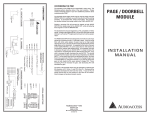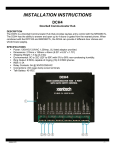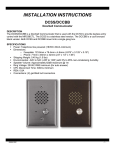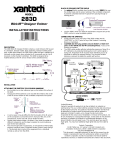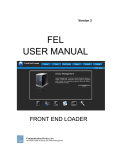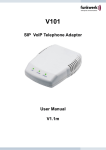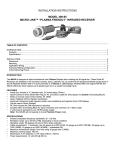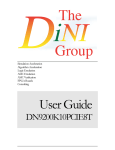Download Xantech Door DPC100 User's Manual
Transcript
INSTALLATION INSTRUCTIONS DPC100 Doorbell / Paging Controller DESCRIPTION The DPC100 is a Doorbell / Paging Controller that can be combined with a MRC88CTL to provide whole-house paging and doorbell capability. Adding the Doorbell Communicator (DCSS or DCBB) and Doorbell Communicator Hub (DCH4) with the MRC88CTL system creates a complete entry control and paging solution. The DPC100 can also provide “Music on hold” for an existing phone line. SPECIFICATIONS Power: 120VAC/13.8VAC 1.25Amp, UL listed adaptor provided. Dimensions: 133mm x 89mm x 44mm (5.25” x 3.5” x 1.75”) Shipping Weight: 1.36 kg (3 lbs) Environmental: 0C to 32C (32F to 90F) with 5% to 95% non-condensing humidity. REN: 0.5A Max Doorbell Switch Wire Run: 305m (1000 ft) max, 24 AWG Max Load on Page Trigger Output: 1kOhm Talk Battery: 36VDC 08905106B -1- 1. Power supply connection. Be sure to use the included power supply only. 2. Doorbell Switch Input (lighted or non-lighted). Provides door chime over speakers (not polarity sensitive). This input can also be connected to a DCH4 for a unique front / back door chimes. 3. C.O. / Phone Line Input. 4. Line Out to Phones. 5. Page Trigger Output. Connect to the MRC88CTL requiring 12VDC signal (or dry relay contact closure) for enabling the paging source input. 6. Music on Hold Input. (mono, 1/8”, 3.5mm) Line Level input from radio, etc. 7. Left and Right Audio Loop Input. (stereo, RCA-type) Line level pre-amp input for background music, etc. 8. Left and Right Audio Output. (stereo, RCA-type) Line level output to external amplifier or MRC88CTL. 9. DIP Switches. For on-hold alarm and mode selections. DIP SWITCH PROGRAMMING SWITCH POSITION 1 OFF 1 ON 2 OFF 2 ON DESCRIPTION On-hold alarm disabled. On-hold alarm tone enabled, a double beep each minute a call is on hold (factory default). Doorbell input connected to a typical doorbell switch (factory default). Doorbell input connected to a DCH4 N.O. auxiliary contact output. Note: Place DIP switches in the desired position then momentarily power down the unit. 08905106B -2- APPLICATION 08905106B -3- OPERATION A. Paging To page throughout the house/small business, simply press #, then 7 (the letter “P” key on your keypad). Speak into the phone receiver and your voice will be heard throughout the house or small business over the speakers. If background music is present over the speakers, it will automatically mute allowing your page to be heard. If you have a caller on the phone, they will automatically be put on hold. You can get the caller back by simply pressing #8 or by momentarily hanging up. Note: The PAGE LED will light during paging. B. Placing a Call On Hold To place a call on hold, simply press # then 6 (the letter “O” key on your keypad), two beeps should be heard confirming the call is on hold, then hang up. The call can then be taken on another phone elsewhere in your home or small business. Optional Music-On-Hold can be provided. C. Releasing a Call On Hold If you hang up the phone after placing a call on hold, simply coming off-hook with any phone will return you to the caller on hold. If you have placed a caller on hold (#6) or have announced a page (#7) and have remained off-hook, enter #8 or momentarily hang up to return to the caller on hold. If the caller hangs up while on hold, the DPC100 can sense a CPC disconnect signal and will automaitcally release the line. Note: The DPC100 has a maximum on-hold call time of 1 hour. After a caller has been on hold for 1 hour, the DPC100 will automatically disconnect the call. D. On-Hold Alarm Tones The DPC100 can provide on-hold alarm tones to alert you that a caller has been left on hold. After each minute the call has been left on hold, the DPC100 will momentarily mute the background music and output a double beep tone over the speakers. This feature can be disabled by setting DIP switch 1 to OFF (see DIP Switch Programming page 2). E. Phone to Phone Intercom This feature allows you to first page someone over the speakers, then speak with them over the phone without the conversation being heard over the speakers. To perform this function, simply press #, then 7 (the “P” key on your keypad), announce your page, then press the numeric 0 key. Another phone coming off-hook will be instantly connected. F. System Bypass The system bypass allows you to use outside phone services (automated attendants, etc.) that require the use of the # key. Come off hook with any phone and enter #9, two confirmation beeps should be heard, hang up the phone. The DPC100 will now ignore all Touch Tone commands on the next off-hook. G. Music Mute To mute the background music any time you are on the phone, simply enter #5. The background music will return when you enter #5 again or hang-up the phone. The MUTE LED will light while the background music is muted. Note: The music mute command (#5) should not be used in multi-line applications. 08905106B -4- I. Door Chime (Doorbell Switch Input) With DIP switch 2 in the OFF position (see DIP Switch Programming, page 2), the doorbell input terminals on the DPC100 can be connected to a normally open switch (lighted or non-lighted doorbell buttons, etc.). When the switch is activated, the unit will momentarily mute the background music and provide a door chime (ding-dong) sound over the speakers. Note: This input is not polarity sensitive and is designed to light standard 6-16V lighted doorbell switches. With DIP switch 2 in the ON position, the doorbell input terminals on the DPC100 can be connected to the DCH4 normally open auxiliary relay contacts. When a door phone on the DCH4 is activated, the DPC100 will momentarily mute the background music and provide a door chime (ding-dong) sound over the speakers. When door phone 2, 3 or 4 on the DCH4 is activated, a single chime (ding) will be heard over the speakers. This is ideal for determining which door the visitor is located at without having to answer the telephone. Note: The DCH4 must have the auxiliary contact mode programmed for custom ring cadence. Note: Touch Tone commands are ignored during doorchimes, loud ringing and on-hold alarm tones. Quick Reference Guide Feature: Touch Tone Command: Page #7 Hold #6 Release Hold # 8 or momentarily hang-up Phone-To-Phone Intercom #7 then 0 System Bypass # 9, then momentarily hang up Music Mute #5 Description: “P” for Page. Speak into the phone receiver and your voice will be heard throughout the house or small business over the speakers. Pressing #7 automatically places a caller on hold, to return to the caller after the page press #8 or momentarily hang-up. “O” for On-Hold. Allows you to place a caller on hold (with music), hang up and take the call on another phone in the house or small business. This releases the caller of hold, allowing you to converse with the caller. This allows you to talk with someone at another phone in the house or small business after a page, without the conversation being heard over the speakers. Enter #9, hear two beeps, and hang-up. The DPC100 will now ignore all commands on the next off-hook. This allows you to use outside phone services (automated attendants, etc.) that require use of the # key. This command allows you to mute the background music coming through your speakers for the duration of an incoming or outgoing call. Standard Features Door Chime: Background music will mute and a door chime (ding-dong) sound will be heard over the speakers. On-Hold Alarm Tones: Each minute the call has been placed on hold, the background music will mute and a double On-Hold alarm tone will be heard over the speakers. Note: This feature can be disabled by setting DIP switch 1 to OFF. Note: Make a copy of the “Quick Reference Guide” and place it under the customers phone. 08905106B -5- FCC REQUIREMENTS This equipment complies with Part 68 of the FCC rules and the requirements adopted by the ACTA. On the side of this equipment is a label that contains, among other information, a product identifier in the format US:AAAEQ##TXXXX. If requested, this number must be provided to the telephone company. The REN is used to determine the number of devices that may be connected to a telephone line. Excessive REN's on a telephone line may result in the devices not ringing in response to an incoming call. In most but not all areas, the sum of the REN's should not exceed five (5.0) To be certain of the number of devices that may be connected to a line, as determined by the total REN's, contact the local telephone company. For products approved after July 23, 2001, the REN for this product is part of the product identifier that has the format US:AAAEQ##TXXXX. The digits represented by ## are the REN without a decimal point (e.g., 03 is a REN of 0.3). For earlier products, the REN is separately shown on the label. The plug used to connect this equipment to the premises wiring and telephone network must comply with the applicable FCC Part 68 rules and requirements adopted by the ACTA. If your home has specially wired alarm equipment connected to the telephone line, ensure the installation of this DPC100 does not disable your alarm equipment. If you have questions about what will disable alarm equipment, consult your telephone company or a qualified installer. If the DPC100 causes harm to the telephone network, the telephone company will notify you in advance that –temporary discontinuance of service may be required. But if advance notice isn't practical, the telephone company will notify the customer as soon as possible. Also, you will be advised of your right to file a complaint with the FCC if you believe it is necessary. The telephone company may make changes in its facilities, equipment, operations, or procedures that could affect the operation of the equipment. If this happens, the telephone company will provide advance notice in order for you to make the necessary modifications to maintain uninterrupted service. If trouble is experienced with the DPC100 for repair or warranty information, please contact: XANTECH CORPORATION, 13100 TELFAIR AVE. SYLMAR, CA 91342 (818) 362-0353 If the equipment is causing harm to the telephone network, the telephone company may request that you disconnect the equipment until the problem is resolved. Connection to Party Line Service is subject to State Tariffs. Contact the state public utility commission, public service commission or corporation commission for information. WHEN PROGRAMMING EMERGENCY NUMBERS AND (OR) MAKING TEST CALLS TO EMERGENCY NUMBERS: Remain on the line and briefly explain to the dispatcher the reason for the call. Perform such activities in the off-peak hours, such as early morning or late evenings. It is recommended that the customer install an AC surge arrester in the AC outlet to which this device is connected. This is to avoid damaging the equipment caused by local lightning strikes and other electrical surges. PART 15 LIMITATIONS This equipment has been tested and found to comply with the limits for a Class A digital device, pursuant to Part 15 of the FCC Rules. These limits are designed to provide reasonable protection against harmful interference when the equipment is operated in a commercial environment. This equipment generates, uses, and can radiate radio frequency energy and, if not installed and used in accordance with the instruction manual, may cause harmful interference to radio communications. Operation of this equipment in a residential area is likely to cause harmful interference in which case the user will be required to correct the interference at his own expense. Xantech Corporation 13100 Telfair Avenue, 2/F Sylmar, CA 91342 Installation Instructions, DPC100 © 2007 Xantech Corporation, Document #08905106B This document is copyright protected. No part of this manual may be copied or reproduced in any form without prior written consent from Xantech Corporation. Xantech Corporation shall not be liable for operational, technical, or editorial errors/omissions made in this document. 08905106B -6-






